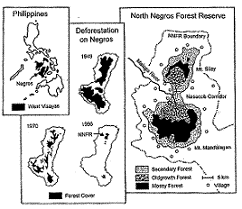 FIGURE 1 illustrates the deforestation, from 1949 to 1996, on the island of Negros in the Philippines, which is where the data for this project was collected.
FIGURE 1 illustrates the deforestation, from 1949 to 1996, on the island of Negros in the Philippines, which is where the data for this project was collected.
Traditionally to determine whether a species is an early, mid or late successional species a series of Life History traits, such as seed size and fruit size, are analyzed to categorize species. This type of classification, although acturate, is very time consuming since many variables need to be collected and analyzed to determine what successional category a species belongs to. If researchers could look at other variables that were easier to collect and easier to analyze then the categorizing process could be shortened and the information gained from the process could be more readily applied to environmental problems, such as deforestation.
Deforestation has become one of the greatest environmental problems facing the Philippines over the last 30 years. Total forest land area has been decreasing in the Philippines since the Spanish colonizers first landed in 1521 (Pulhin, 2002) and major deforestation occurred between 1970 ad 1990. Between 1970 and 1990 land use in the Philippines has shifted to primarily large-scale-logging forestry (Verburg, Overmars, Huigen, de Grout & Veldkemp, 2006). As expected, the logging industry greatly impacted the amount of original forests remaining in the Philippines, and as a result the Filipino Government responded by implementing a ban on logging old growth forests in the Philippines (Pulhin, 2002), and created park boundaries to protect forest areas that were considered to have high levels of biodiversity, under the National Integrated Protected Area System (NIPAS) Act in 1992 (Verburg, Overmars, Huigen, de Grout & Veldkemp, 2006). While implementing the NIPAS Act was greatly needed to protect the remaining forest land, unfortunately it has not stopped some of these areas from being illegally logged. Currently only 25% of the 200 protected areas listed in the NIPAS Act are actively protected (Verburg, Overmars, Huigen, de Grout & Veldkemp, 2006), and as a result loggers have the opportunity to illegally harvest these protected areas without consequences.
 FIGURE 1 illustrates the deforestation, from 1949 to 1996, on the island of Negros in the Philippines, which is where the data for this project was collected.
FIGURE 1 illustrates the deforestation, from 1949 to 1996, on the island of Negros in the Philippines, which is where the data for this project was collected.
Currently the Filipino Government is focusing on replanting clear-cut stands to regenerate forests that can be harvested, but the main reason that illegal logging is happening in the Philippines is that the Old Growth forests have high concentrations of late successional species that are highly sought after. Wood from many late successional species is more profitable to loggers, but and these species cannot be quickly grown. Attempts to replant clear-cut stands with these species have failed because the conditions of the clear-cut stands are not viable for mid and late successional species. The failure of these stands forces loggers who are seeking out profitable late successional species to turn to illegally logging Old Growth forests.
While this project is firstly focused on classifying unknown successions of species into either early successional, mid successional or late successional, through a series of Multivariate Analyses, the knowledge gained can be further used to distinguish any species that are known to be profitable late successional species that act as though they are early successional species. This knowledge is useful because if the species are planted in clear-cut stands the replanted stands may have less likelihood of failing and therefore relieve some stress on Old Growth forests by illegal loggers.
HOME
INTRODUCTION
DATA DETAILS
MULTIVARIATE METHODS
MULTIVARIATE RESULTS & DISCUSSION
CONCLUSION
APPENDICES
REFERENCES & ACKNOWLEDGEMENTS
DATA PREPARATION METHODS
DATA PREPARATION RESULTS & DISCUSSION
PRELIMINARY ANALYSIS